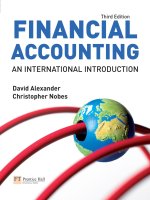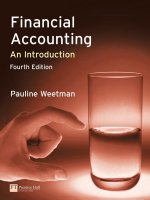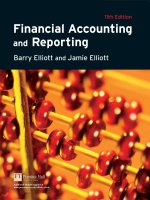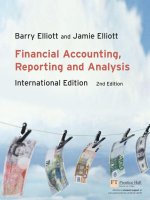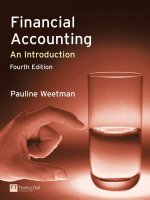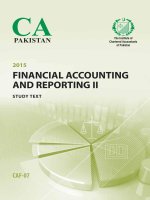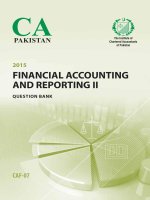Financial accounting and reporting international edition 11th edition by barry elliott and jamie elliott
Bạn đang xem bản rút gọn của tài liệu. Xem và tải ngay bản đầy đủ của tài liệu tại đây (6.69 MB, 897 trang )
11th Edition
Financial Accounting
and Reporting
Barry Elliott and Jamie Elliott
Additional student support at
www.pearsoned.co.uk/elliott_elliott
Financial Accounting
and Reporting
Visit the Financial Accounting and Reporting, eleventh edition,
Companion Website at www.pearsoned.co.uk/
elliott-elliott
to find valuable student learning material including:
•
•
•
•
Extracts from the financial press.
A selection of extended questions and answers.
Over 500 multiple choice questions to test your learning.
Additional case studies based on real companies.
We work with leading authors to develop the
strongest educational materials in business and finance,
bringing cutting-edge thinking and best learning
practice to a global market.
Under a range of well-known imprints, including
Financial Times Prentice Hall, we craft high-quality
print and electronic publications which help readers
to understand and apply their content, whether
studying or at work.
To find out more about the complete range of our
publishing please visit us on the World Wide Web at:
www.pearsoned.co.uk
Financial Accounting
and Reporting
ELEVENTH EDITION
Barry Elliott and Jamie Elliott
Pearson Education Limited
Edinburgh Gate
Harlow
Essex CM20 2JE
England
and Associated Companies throughout the world
Visit us on the World Wide Web at:
www.pearsoned.co.uk
First published 1993
Second edition 1996
Third edition 1999
Fourth edition 2000
Fifth edition 2001
Sixth edition 2002
Seventh edition 2003
Eighth edition 2004
Ninth edition published 2005
Tenth edition published 2006
Eleventh edition published 2007
© Prentice Hall International UK Limited 1993, 1999
© Pearson Education Limited 2000, 2006
The rights of Barry Elliott and Jamie Elliott to be identified as authors of this
work have been asserted by them in accordance with the Copyright, Designs,
and Patents Act 1988.
All rights reserved. No part of this publication may be reproduced, stored in
a retrieval system, or transmitted in any form or by any means, electronic,
mechanical, photocopying, recording, or otherwise, without either the prior
written permission of the Publishers or a licence permitting restricted copying
in the United Kingdom issued by the Copyright Licensing Agency Ltd,
90 Tottenham Court Road, London W1T 4LP.
ISBN-13 978-0-273-70870-4
ISBN-10 0-273-70870-8
British Library Cataloguing-in-Publication Data
A catalogue record for this book is available from the British Library.
10 9 8 7 6 5 4 3 2 1
10 09 08 07
Typeset in 9/12pt Ehrhardt by 25.
Printed by Ashford Colour Press Ltd, Gosport.
The publisher’s policy is to use paper manufactured from sustainable forests.
Brief Contents
Preface and acknowledgements
Part 1
INCOME AND ASSET VALUE MEASUREMENT SYSTEMS
1
2
3
4
Accounting and reporting on a cash flow basis
Accounting and reporting on an accrual accounting basis
Income and asset value measurement: an economist’s approach
Accounting for inflation
xx
1
3
22
40
60
Part 2
REGULATORY FRAMEWORK – AN ATTEMPT TO ACHIEVE
UNIFORMITY
5 Financial reporting – evolution of the regulatory framework in the UK
6 Financial reporting – evolution of international standards
7 Conceptual framework
8 Published accounts of companies
9 Preparation of published accounts
99
101
137
161
186
233
Part 3
BALANCE SHEET – EQUITY, LIABILITY AND ASSET
MEASUREMENT AND DISCLOSURE
257
10
11
12
13
14
15
16
17
18
19
259
285
319
339
362
389
422
442
478
504
Share capital, distributable profits and reduction of capital
Off balance sheet finance
Financial instruments
Employee benefits
Taxation in company accounts
Property, plant and equipment (PPE)
Leasing
R&D; goodwill and intangible assets; brands
Inventories
Construction contracts
vi • Brief Contents
Part 4 CONSOLIDATED ACCOUNTS
519
20
21
22
23
24
521
538
550
568
583
Accounting for groups at date of acquisition
Preparation of consolidated balance sheets after the date of acquisition
Preparation of consolidated income statements
Accounting for associated companies
Accounting for the effects of changes in foreign exchange rates under IAS 21
Part 5 INTERPRETATION
601
25
26
27
28
29
603
629
653
694
734
Earnings per share
Cash flow statements
Review of financial ratio analysis
Trend analysis and multivariate analysis
An introduction to financial reporting on the Internet
Part 6 ACCOUNTABILITY
747
30 Corporate governance
31 Environmental and social reporting
32 Ethics for accountants
749
795
831
Appendix: Outline solutions to selected exercises
Index
855
863
Full Contents
Preface and acknowledgements
Part 1
INCOME AND ASSET VALUE MEASUREMENT SYSTEMS
1 Accounting and reporting on a cash flow basis
1.1
1.2
1.3
1.4
1.5
1.6
1.7
1.8
1.9
1.10
1.11
1.12
Introduction
Shareholders
What skills does an accountant require in respect of external reports?
Managers
What skills does an accountant require in respect of internal reports?
Procedural steps when reporting to internal users
Agency costs
Illustration of periodic financial statements prepared under the cash flow
concept to disclose realised operating cash flows
Illustration of preparation of balance sheet under the cash flow concept
Treatment of non-current assets in the cash flow model
What are the characteristics of these data that make them reliable?
Reports to external users
Summary
Review questions
Exercises
References
2 Accounting and reporting on an accrual accounting basis
2.1
2.2
2.3
2.4
2.5
2.6
2.7
2.8
2.9
Introduction
Historical cost convention
Accrual basis of accounting
Mechanics of accrual accounting – adjusting cash receipts and payments
Subjective judgements required in accrual accounting – adjusting cash
receipts in accordance with lAS 18
Subjective judgements required in accrual accounting – adjusting cash
payments in accordance with the matching principle
Mechanics of accrual accounting – the balance sheet
Reformatting the statement of financial position into a balance sheet
Accounting for the sacrifice of non-current assets
xx
1
3
3
4
4
5
5
6
8
9
13
14
15
16
17
18
18
21
22
22
23
24
24
25
27
27
28
29
viii • Full Contents
2.10
Reconciliation of cash flow and accrual accounting data
Review questions
Exercises
References
32
34
35
38
3 Income and asset value measurement: an economist’s approach 40
3.1
3.2
3.3
3.4
3.5
3.6
3.7
Introduction
Role and objective of income measurement
Accountant’s view of income, capital and value
Critical comment on the accountant’s measure
Economist’s view of income, capital and value
Critical comment on the economist’s measure
Income, capital and changing price levels
Summary
Review questions
Exercises
References
Bibliography
4 Accounting for inflation
4.1
4.2
4.3
4.4
4.5
4.6
4.7
4.8
4.9
4.10
4.11
Financial reporting – evolution of the regulatory framework
in the UK
5.1
5.2
5.3
5.4
5.5
5.6
60
Introduction
60
Review of the problems of historical cost accounting (HCA)
60
Inflation accounting
61
The concepts in principle
61
The four models illustrated for a company with cash purchases and sales 63
Critique of each model
66
Operating capital maintenance – a comprehensive example
69
Critique of CCA statements
80
The ASB approach
82
The IASC/IASB approach
84
Future developments
86
Summary
86
Review questions
87
Exercises
88
References
97
Bibliography
97
Part 2
REGULATORY FRAMEWORK – AN ATTEMPT TO ACHIEVE
UNIFORMITY
5
40
40
43
46
47
53
53
55
55
56
58
59
Introduction
Mandatory regulations
Arguments in support of standards
Arguments against standards
Structure of regulatory framework
The Operating and Financial Review (OFR)
99
101
101
101
105
107
107
110
Full Contents • ix
5.7
5.8
5.9
5.10
5.11
5.12
6
6.1
6.2
6.3
6.4
6.5
6.6
6.7
The Financial Reporting Review Panel
The Financial Services Authority
The Revised Combined Code (July 2003)
Interim reports following Cadbury
Developments for small companies
Evaluation of effectiveness of mandatory regulations
Summary
Review questions
Exercises
References
Financial reporting – evolution of international
standards
Introduction
National differences
Reasons for differences in financial reporting
Classification of national accounting systems
Attempts to reduce national differences
The work of international bodies in harmonising and standardising
financial reporting
US GAAP
Summary
Review questions
Exercises
References
7
Conceptual framework
7.1
7.2
7.3
Introduction
Historical overview of the evolution of financial accounting theory
IASC Framework for the Presentation and Preparation of Financial
Statements
ASB Statement of Principles 1999
AICPA Improving Business Reporting – A Customer Focus:
Meeting the Information Needs of Investors and Creditors
ICAS Making Corporate Reports Valuable
Summary
Review questions
Exercises
References
7.4
7.5
7.6
8
Published accounts of companies
8.1
8.2
8.3
Introduction
A public company’s financial calendar
Criteria for information appearing in a published income statement
and balance sheet
The prescribed formats – the income statement
What information is required to be disclosed in Format 1 and
Format 2?
8.4
8.5
116
119
120
122
125
132
134
134
135
135
137
137
137
138
143
143
145
156
158
159
159
160
161
161
162
165
167
177
178
179
181
182
185
186
186
187
188
188
189
x • Full Contents
8.6
8.7
8.8
8.9
8.10
8.11
8.12
8.13
8.14
8.15
8.16
8.17
8.18
8.19
8.20
8.21
8.22
Cost of sales
Distribution costs
Administrative expenses
Other operating income
What costs and income are brought into account after calculating
the trading profit in order to arrive at the profit on ordinary activities
before tax?
Does it really matter under which heading a cost is classified in the
income statement provided it is not omitted?
Discontinued operations disclosure in the income statement
Items requiring separate disclosure
The prescribed formats – the balance sheet
Statement of changes in equity
Reporting performance
Segment reporting
The fundamental accounting principles underlying the published income
statement and balance sheet
Disclosure of accounting policies
Fair view treatment
Additional information in the annual report
What information do companies provide to assist comparison
between companies reporting under different reporting regimes?
Summary
Review questions
Exercises
References
9 Preparation of published accounts
9.1
9.2
9.3
9.4
9.5
9.6
9.7
Introduction
Stage 1: preparation of the internal income statement from a trial
balance
Stage 2: preparation of the income statement of Illustrious SpA in
Format 1 style
Stage 3: preparation of the balance sheet
Preparation of accounts in Format 1 following IAS 8 and IFRS 5
Additional information value of IFRS 5
Additional information value of IAS 24
Summary
Review questions
Exercises
References
190
194
194
194
194
195
195
198
198
202
205
208
208
209
213
216
219
222
222
224
231
233
233
233
235
238
239
243
244
246
247
248
256
Part 3
BALANCE SHEET – EQUITY, LIABILITY AND ASSET
MEASUREMENT AND DISCLOSURE
257
10 Share capital, distributable profits and reduction of capital
259
10.1
10.2
Introduction
Total owners’ equity: an overview
259
261
Full Contents • xi
10.3
10.4
10.5
10.6
10.7
10.8
10.9
10.10
10.11
10.12
10.13
10.14
Total shareholders’ funds: more detailed explanation
Accounting entries on issue of shares
Creditor protection: capital maintenance concept
Creditor protection: why capital maintenance rules are necessary
Creditor protection: how to quantify the amounts available to meet
creditors’ claims
Issued share capital: minimum share capital
Distributable profits: general considerations
Distributable profits: how to arrive at the amount using relevant
accounts
When may capital be reduced?
Writing off part of capital which has already been lost and is not
represented by assets
Repayment of part of paid-in capital to shareholders or cancellation of
unpaid share capital
Purchase of own shares
Summary
Review questions
Exercises
References
11 Off balance sheet finance
11.1
11.2
11.3
11.4
11.5
11.6
11.7
11.8
11.9
11.10
11.11
11.12
Introduction
Primary financial statements: their interrelationship
Primary financial statements: changes in their interrelationship
Reasons that companies borrow
Capital gearing and its implications
Off balance sheet finance
Substance over form
Impact of converting to IFRS
Balance sheet as valuation document
Why companies take steps to strengthen their balance sheets
Definitions cannot remove uncertainty: IAS 10 and IAS 37
ED IAS 37 Non-financial Liabilities
Summary
Review questions
Exercises
References
12 Financial instruments
12.1
12.2
12.3
Introduction
IAS 32 Financial Instruments: Disclosure and Presentation
IAS 39 Financial Instruments: Recognition and Measurement
Summary
Review questions
Exercises
References
262
264
265
266
266
267
268
269
269
270
276
276
279
279
280
284
285
285
285
286
286
287
289
290
294
295
297
298
306
313
314
315
318
319
319
319
328
335
336
336
338
xii • Full Contents
13 Employee benefits
13.1
13.2
13.3
13.4
13.5
13.6
13.7
13.8
13.9
13.10
13.11
13.12
13.13
13.14
13.15
13.16
Introduction
Financial reporting implications
Types of scheme
Defined contribution pension schemes
Defined benefit pension schemes
IAS 19 (revised) Employee Benefits
The liability for pension and other post-retirement costs
The income statement
Comprehensive illustration
Plan curtailments and settlements
Multi-employer plans
Disclosures
Other long-service benefits
Short-term benefits
Termination benefits
IAS 26 Accounting and Reporting by Retirement Benefit Plans
Summary
Review questions
Exercises
References
14 Taxation in company accounts
14.1
14.2
14.3
14.4
14.5
14.6
14.7
14.8
14.9
14.10
14.11
14.12
Introduction
Corporation tax
Corporation tax systems – the theoretical background
Corporation tax systems – avoidance and evasion
Corporation tax – the system from 6 April 1999
IFRS and taxation
IAS 12 – accounting for current taxation
Deferred tax
FRS 19 (the UK standard on deferred taxation)
A critique of deferred taxation
Examples of companies following IAS 12
Value added tax (VAT)
Summary
Review questions
Exercises
References
15 Property, plant and equipment (PPE)
15.1
15.2
15.3
15.4
15.5
15.6
15.7
15.8
15.9
Introduction
What is PPE?
How is the cost of PPE determined?
What is depreciation?
What are the constituents in the depreciation formula?
How is the useful life of an asset determined?
Residual value
Calculation of depreciation
Measurement subsequent to initial recognition
339
339
340
340
342
343
345
345
348
349
351
351
352
352
353
354
355
357
358
359
361
362
362
362
363
364
366
368
369
371
378
379
384
384
385
386
386
387
389
389
390
391
393
396
397
397
398
402
Full Contents • xiii
15.10
15.11
15.12
15.13
15.14
15.15
IAS 36 Impairment of Assets
IFRS 5 Non-Current Assets Held for Sale and Discontinued Operations
Disclosure requirements
Government grants towards the cost of PPE
Investment properties
Effect of accounting policy for PPE on the interpretation of the financial
statements
Summary
Review questions
Exercises
References
404
409
410
411
412
413
415
416
416
421
16 Leasing
422
16.1
16.2
16.3
16.4
16.5
16.6
16.7
16.8
16.9
422
422
424
426
428
433
434
435
436
437
438
439
441
Introduction
Background to leasing
IAS 17 (and its national equivalents) – the controversy
IAS 17 – classification of a lease
IAS 17 – accounting for leases by lessees
Accounting for the lease of land and buildings
Leasing – a form of off balance sheet financing
Accounting for leases – a new approach
Accounting for leases by lessors
Summary
Review questions
Exercises
References
17 R&D; goodwill and intangible assets; brands
17.1
17.2
17.3
17.4
17.5
17.6
17.7
17.8
17.9
17.10
Introduction
Accounting treatment for research and development
Research and development
Introduction to goodwill and intangible assets
Application of IAS 38 Intangible Assets
Is there a correct treatment for amortising goodwill?
Other types of intangible assets under IAS 38
Disclosure of intangible assets under IAS 38
Brand accounting
Intellectual property
Summary
Review questions
Exercises
References
18 Inventories
18.1
18.2
18.3
18.4
18.5
18.6
Introduction
Inventory defined
The controversy
IAS 2 Inventories
Inventory valuation
Work-in-progress
442
442
442
444
449
449
454
459
459
463
465
470
470
472
476
478
478
478
479
480
481
488
xiv • Full Contents
18.7
18.8
18.9
18.10
18.11
Inventory control
Creative accounting
Audit of the year-end physical inventory count
Published accounts
Agricultural activity
Summary
Review questions
Exercises
References
19 Construction contracts
19.1
19.2
19.3
19.4
19.5
Introduction
Identification of contract revenue
Identification of contract costs
Recognition of contract revenue and expenses
Public–private partnerships (PPPs)
Summary
Review questions
Exercises
References
490
491
493
495
496
498
499
499
503
504
504
504
505
505
508
513
514
514
518
Part 4
CONSOLIDATED ACCOUNTS
519
20 Accounting for groups at date of acquisition
521
20.1
20.2
20.3
20.4
20.5
20.6
20.7
20.8
Introduction
The definition of a group
Consolidated accounts and some reasons for their preparation
The definition of control
Alternative methods of preparing consolidated accounts
The treatment of positive goodwill
The treatment of negative goodwill
The comparison between an acquisition by cash and an exchange
of shares
20.9 Minority interests
20.10 The treatment of differences between a subsidiary’s fair value and
book value
20.11 How to calculate fair values
Summary
Review questions
Exercises
References
21 Preparation of consolidated balance sheets after the date of
acquisition
21.1
21.2
21.3
21.4
21.5
Introduction
Pre- and post-acquisition profits/losses
Inter-company balances
Unrealised profit on inter-company sales
Provision for unrealised profit affecting a minority
521
521
521
523
524
525
526
526
526
528
529
530
530
532
537
538
538
538
540
542
546
Full Contents • xv
21.6
21.7
Uniform accounting policies and reporting dates
How is the investment in subsidiaries reported in the parent’s own
balance sheet?
Summary
Review questions
Exercises
References
22 Preparation of consolidated income statements
22.1
22.2
22.3
22.4
22.5
Introduction
Preparation of a consolidated income statement – the Ante Group
Dividends or interest paid by the subsidiary out of pre-acquisition
profits
A subsidiary acquired part of the way through the year
Published format income statement
Summary
Review questions
Exercises
References
23 Accounting for associated companies
23.1
23.2
23.3
23.4
23.5
23.6
23.7
546
546
546
547
547
549
550
550
550
553
554
557
557
558
558
567
568
Introduction
Definitions of associates and of significant influence
The treatment of associated companies in consolidated accounts
The Brill Group – the equity method illustrated
The treatment of provisions for unrealised profits
The acquisition of an associate part-way through the year
Joint ventures
Summary
Review questions
Exercises
References
568
568
569
569
572
572
574
575
576
576
582
24 Accounting for the effects of changes in foreign exchange
rates under IAS 21
583
24.1
24.2
Introduction
The difference between conversion and translation and the definition
of a foreign currency transaction
24.3 The functional currency
24.4 The presentation currency
24.5 Monetary and non-monetary items
24.6 The rules on the recording of foreign currency transactions
24.7 The treatment of exchange differences on foreign exchange
transactions
24.8 Foreign exchange transactions in the individual accounts of companies
illustrated – Boil plc
24.9 The translation of the accounts of foreign operations where the
functional currency is the same as that of the parent
24.10 Granby Ltd illustration
583
583
584
584
585
585
585
586
587
587
xvi • Full Contents
24.11 The use of a presentation currency other than the functional
currency
24.12 Granby Ltd illustration continued
24.13 Implications of IAS 21
Summary
Review questions
Exercises
References
594
595
596
597
597
598
600
Part 5
INTERPRETATION
601
25 Earnings per share
603
25.1
25.2
25.3
25.4
25.5
25.6
25.7
25.8
Introduction
Why is the earnings per share figure important?
How is the EPS figure calculated?
The use to shareholders of the EPS
Illustration of the basic EPS calculation
Adjusting the number of shares used in the basic EPS calculation
Rights issues
Adjusting the earnings and number of shares used in the diluted EPS
calculation
25.9 Procedure where there are several potential dilutions
25.10 Exercise of conversion rights during financial year
25.11 Disclosure requirements of IAS 33
25.12 The Improvement Project
Summary
Review questions
Exercises
References
26 Cash flow statements
26.1
26.2
26.3
26.4
26.5
26.6
26.7
Introduction
Development of cash flow statements
Applying IAS 7 (revised) Cash Flow Statements
IAS 7 (revised) format of cash flow statements
Consolidated cash flow statements
Analysing a cash flow statement
Critique of cash flow accounting
Summary
Review questions
Exercises
References
27 Review of financial ratio analysis
27.1
27.2
27.3
27.4
27.5
27.6
Introduction
Accounting ratios and ratio analysis
Six key ratios
Description of the six key ratios
Description of subsidiary ratios
Application of pyramid of ratios to JD Wetherspoon plc
603
603
604
605
606
606
609
614
616
618
619
621
621
622
623
627
629
629
629
630
632
636
639
641
642
643
643
652
653
653
654
655
657
659
665
Full Contents • xvii
27.7
27.8
27.9
27.10
27.11
27.12
Segmental analysis
Inter-firm comparisons and industry averages
Ensuring true inter-firm comparisons
World Wide Web pages for company information
Non-financial ratios
Interpretation problems when using ratios and consolidated
financial statements
Summary
Review questions
Exercises
References
28 Trend analysis and multivariate analysis
28.1
28.2
28.3
28.4
28.5
28.6
28.7
28.8
28.9
28.10
28.11
28.12
28.13
28.14
28.15
28.16
28.17
28.18
28.19
Introduction
Horizontal analysis between two periods
Trend analysis over a series of periods
Historical summaries
Vertical analysis – common size statements
Multivariate analysis – Z-scores
H-scores
A-scores
Combining cash flow and accrual data
Accounting polices
Balanced scorecards
Valuing shares of an unquoted company – quantitative process
Valuing shares of an unquoted company – qualitative process
Shareholder value analysis (SVA)
Measuring and reporting values in the annual report
Shareholder information needs
Professional risk assessors
Aggressive earnings management
Impact of differences between IFRSs and national standards on
trend analysis
Summary
Review questions
Exercises
References
29 An introduction to financial reporting on the Internet
29.1
29.2
29.3
29.4
29.5
29.6
29.7
Introduction
What is XBRL?
What XBRL is not
How can it be used?
What is needed to use XBRL?
Progress of XBRL development
Companies currently using XBRL
Summary
Review questions
Exercises
Supplementary reading
667
674
675
678
679
679
682
682
683
693
694
694
694
696
698
698
701
703
704
705
705
706
707
709
710
711
716
719
721
722
723
723
726
732
734
734
735
737
737
740
741
743
743
743
744
745
xviii • Full Contents
Part 6
ACCOUNTABILITY
747
30 Corporate governance
749
30.1
30.2
30.3
30.4
30.5
30.6
30.7
30.8
30.9
30.10
30.11
30.12
30.13
30.14
30.15
30.16
30.17
30.18
Introduction
The need for corporate governance guidelines
Corporate governance in different countries
Corporate governance requirements
UK Voluntary Code – The Cadbury Report
The Greenbury Report
The Hampel Report
The Higgs Report
The Smith Report
The Combined Code
Directors’ remuneration
Directors’ remuneration – illustration from the Annual Report of
Diageo plc
Directors’ remuneration – conclusion
Relations with shareholders
Institutional investors
The Myners Report
Corporate governance – directors’ remuneration summary
Auditors
Summary
Review questions
Exercises
References
31 Environmental and social reporting
31.1
31.2
31.3
31.4
31.5
31.6
31.7
31.8
31.9
31.10
31.11
31.12
31.13
31.14
31.15
31.16
Introduction
Accountants’ role in a capitalist industrial society
Sustainability
Background to companies’ reporting practices
European Commission recommendations for disclosures in
annual accounts
Evolution of stand-alone environmental reports
International charters and guidelines
Economic consequences of environmental reporting
Summary on environmental reporting
Environmental auditing: international initiatives
The activities involved in an environmental audit
Concept of social accounting
Background to social accounting
Corporate social responsibility
Need for comparative data
International initiatives towards triple bottom line reporting
Summary
Review questions
Exercises
References
Bibliography
749
749
750
752
755
756
757
757
760
761
761
765
775
775
776
777
778
779
788
788
790
794
795
795
795
796
797
798
800
801
805
805
806
807
810
811
814
816
818
821
821
822
828
829
Full Contents • xix
32 Ethics for accountants
32.1
32.2
32.3
32.4
32.5
32.6
32.7
32.8
32.9
Introduction
The nature of business ethics
Ethical codes for businesses
The background to business ethics
The role of ethics in modern business
The role of professional accounting ethics
The role of the accountant as guardian of business ethics
Growth of voluntary standards
Conflict between Codes and Targets
Summary
Review questions
References
Bibliography
Appendix: Outline solutions to selected exercises
Index
830
830
830
833
835
837
840
845
846
849
849
850
852
852
855
863
Preface and acknowledgements
Our objective is to provide a balanced and comprehensive framework to enable students
to acquire the requisite knowledge and skills to appraise current practice critically and to
evaluate proposed changes from a theoretical base. To this end, the text contains:
●
●
●
●
●
●
current standards,
illustrations from published accounts,
a range of review questions,
exercises of varying difficulty,
outline solutions to selected exercises in an Appendix at the end of the book,
extensive references.
We have assumed that readers will have an understanding of financial accounting to a
foundation or first-year level, although the text and exercises have been designed on the
basis that a brief revision is still helpful.
Lecturers are using the text selectively to support a range of teaching programmes for
second-year and final-year undergraduate and postgraduate programmes. We have therefore attempted to provide subject coverage of sufficient breadth and depth to assist selective use.
The text has been adopted for financial accounting, reporting and analysis modules on:
●
●
●
●
●
second-year undergraduate courses for Accounting, Business Studies and Combined
Studies;
final-year undergraduate courses for Accounting, Business Studies and Combined
Studies;
MBA courses;
specialist MSc courses; and
professional courses preparing students for professional accountancy examinations.
Changes to the eleventh edition
Accounting standards
UK listed companies, together with those non-listed companies that so choose, will apply
international standards from January 2005.
For non-listed companies that choose to continue to apply UK GAAP, the ASB has
stated its commitment to progressively bringing UK GAAP into line with international
Preface and acknowledgements • xxi
standards and the seven FRSs 20–26 that have been issued since April 2004 are part of
this process.
For companies currently applying FRSSE, this will continue but the IASB are looking
in the medium term at the possibility of issuing an international equivalent.
Accounting standards – eleventh edition updates
Chapters 5 and 6 cover the evolution of the regulatory framework in the UK and the
evolution of international standards.
Topics and International Standards are covered as follows:
Chapter 4
Chapter 8
Chapter
Chapter
Chapter
Chapter
Chapter
Chapter
9
11
12
13
14
15
Chapter 16
Chapter 17
Chapter 18
Chapter 19
Chapters 20
Chapter 25
Chapter 26
Chapter 30
Accounting for inflation
Published accounts of companies
IAS 29
IAS 1, IAS 14, IAS 37, IFRS 1 and
IFRS 5
Preparation of published accounts
IAS 1, IAS 8, IAS 24 and IAS 35
Off balance sheet finance
IAS 37
Financial instruments
IAS 32, IAS 39 and IFRS 7
Employee benefits
IAS 19 and IAS 26
Taxation in company accounts
IAS 12
Property, plant and equipment (PPE) IAS 16, IAS 20, IAS 23, IAS 36,
IAS 40 and IFRS 5
Leasing
IAS 17
R&D; goodwill and intangible assets;
brands
IAS 38 and IFRS 3
Inventories
IAS 2
Construction contracts
IAS 11
to 25 Consolidation
IAS 21, IAS 27, IAS 28, IAS 31 and
IFRS 3
Earnings per share
IAS 33
Cash flow statements
IAS 7
Corporate governance
IFRS 2
Income and asset value measurement systems
Chapters 1 to 4 continue to cover accounting and reporting on a cash flow and accrual
basis, the economic income approach and accounting for changing price levels.
The UK regulatory framework and analysis
UK listed companies will continue to be subject to national company law, and mandatory
and best practice requirements such as the Operating and Financial Review and the
Combined Code.
UK regulatory framework and analysis – eleventh edition changes
Chapter 10 Share capital, capital maintenance and distributable profits and
Chapter 11 Reduction of share capital have been combined.
The following chapters have been retained and updated as appropriate:
Chapter 11 Off balance sheet finance
Chapter 27 Review of financial ratio analysis
Chapter 28 Trend analysis and multivariate analysis
xxii • Preface and acknowledgements
Chapter
Chapter
Chapter
Chapter
29
30
31
32
Financial Reporting on the Internet
Corporate governance
Environmental and social reporting
Ethics for accountants
Our emphasis has been on keeping the text current and responsive to constructive
comments from reviewers.
Recent developments
In addition to the steps being taken towards the development of IFRSs that will receive
broad consensus support, regulators have been active in developing further requirements
concerning corporate governance. These have been prompted by the accounting scandals
in the USA and, more recently, in Europe and by shareholder activism fuelled by the
apparent lack of any relationship between increases in directors’ remuneration and company performance.
The content of financial reports continues to be subjected to discussion with a tension
between preparers, stakeholders, auditors, academic accountants and standard setters; this
is mirrored in the tension that exists between theory and practice.
●
●
●
●
●
Preparers favour reporting transactions on a historical cost basis which is reliable but
does not provide shareholders with relevant information to appraise past performance
or to predict future earnings.
Stakeholders favour forward-looking reports relevant in estimating future dividend and
capital growth and in understanding environmental and social impacts.
Auditors favour reports that are verifiable so that the figures can be substantiated to
avoid them being proved wrong at a later date.
Academic accountants favour reports that reflect economic reality and are relevant in
appraising management performance and in assessing the capacity of the company to
adapt.
Standard setters lean towards the academic view and favour reporting according to the
commercial substance of a transaction.
In order to understand the tensions that exist, students need:
●
●
●
●
●
the skill to prepare financial statements in accordance with the historical cost and
current cost conventions, both of which appear in annual financial reports;
an understanding of the main thrust of mandatory and voluntary standards;
an understanding of the degree of flexibility available to the preparers and the impact
of this on reported earnings and the balance sheet figures;
an understanding of the limitations of these financial reports in portraying economic
reality; and
an exposure to source material and other published material in so far as time permits.
Instructor’s Manual
A separate Instructor’s Manual has been written to accompany this text. It contains fully
worked solutions to all the exercises and is of a quality that allows them to be used as
Preface and acknowledgements • xxiii
overhead transparencies. The Manual is available at no cost to lecturers on application to
the publishers.
Website
An electronic version of the Manual is also available for download at
www.pearsoned.co.uk/elliott_elliott.
Acknowledgements
Financial reporting is a dynamic area and we see it as extremely important that the text
should reflect this and be kept current. Assistance has been generously given by
colleagues and many others in the preparation and review of the text and assessment
material. This eleventh edition is very much a result of the authors, colleagues, reviewers and Pearson editorial and production staff working as a team and we are grateful to
all concerned for their assistance in achieving this.
We owe particular thanks to Sally Aisbitt of the Open University, who has updated
the chapter ‘Financial reporting – evolution of international standards’ (Chapter 6); Ron
Altshul of Leeds Metropolitan University, who has updated ‘Taxation in company
accounts’ (Chapter 14); Charles Batchelor of the Financial Training Company for
‘Employee benefits’ (Chapter 13) and Financial Instruments (Chapter 12); Steve
Dungworth of De Montfort University, for ‘Ethics for accountants’ (Chapter 32), which
first appeared in the third edition; Ozer Erman of Kingston University, for ‘Share capital, distributable profits and Reduction of share capital’ (Chapter 10), which first appeared
in the second edition; Mike O’Meara of the Regents Business School for consolidation
chapters; Paul Robins of Financial Training Company for ‘Property, plant and equipment’ (Chapter 15) and ‘Construction contracts’ (Chapter 19); Professor Garry Tibbits
of the University of Western Sydney for Leasing (Chapter 16); Hendrika Tibbits of the
University of Western Sydney for An Introduction to Financial Reporting on the Internet
(Chapter 29); David Towers, formerly of Keele University, for R&D; Goodwill and
intangible assets and ‘Corporate governance’ (Chapter 30); and Martin Howes for inputs
to financial analysis.
The authors are grateful for the constructive comments received from the following
reviewers which have assisted us in making improvements: Iain Fleming of the University
of Paisley, John Morley of the University of Brighton, John Forker of Queen’s
University, Belfast, Breda Sweeney of Cork University, Patricia McCourt Larres of
Queen’s University, Belfast, and Dave Knight of Leeds Metropolitan University.
Thanks are owed to A.T. Benedict of the South Bank University, Keith Brown of De
Montfort University, Kenneth N. Field of the University of Leeds, Sue McDermott of
London Guildhall University, David Murphy of Manchester Metropolitan University,
Bahadur Najak of the University of Durham, Graham Sara of Coventry University, Laura
Spira of Oxford Brookes University, Ken Trunkfield, formerly of the University of
Derby, and Martin Tuffy of the University of Brighton.
Thanks are also due to the following organisations: the Accounting Standards Board,
the International Accounting Standards Board, the Association of Chartered Certified
Accountants, the Association of International Accountants, the Chartered Institute of
Management Accountants, the Institute of Chartered Accountants of Scotland, Chartered
xxiv • Preface and acknowledgements
Institute of Public Finance and Accountancy, Chartered Institute of Bankers and the
Institute of Investment Management and Research.
We would also like to thank the authors of some of the end-of-chapter exercises. Some
of these exercises have been inherited from a variety of institutions with which we have
been associated, and we have unfortunately lost the identities of the originators of such
material with the passage of time. We are sorry that we cannot acknowledge them by
name and hope that they will excuse us for using their material.
We are indebted to Matthew Smith and Georgina Clark-Mazo of Pearson Education
for active support in keeping us largely to schedule and the attractively produced and
presented text.
Finally we thank our wives, Di and Jacklin, for their continued good humoured
support during the period of writing and revisions, and Giles Elliott for his critical
comment at the commencement of the project. We alone remain responsible for any
errors and for the thoughts and views that are expressed.
Barry and Jamie Elliott
Publisher’s acknowledgements
We are grateful to the Financial Times Limited for permission to reprint the following
material:
Lex column, © Financial Times, 17 November 2000; Early warning signals, © Financial
Times, 5 October 1999.
Supporting resources
Visit www.pearsoned.co.uk/elliott-elliott to find valuable online resources
Companion Website for students
• Extracts from the financial press.
• A selection of extended questions and answers.
• Over 500 multiple choice questions to test your learning.
• Additional case studies based on real companies.
For instructors
• PowerPoint slides that can be downloaded and used for presentations.
• Downloadable Instructor’s Manual including worked solutions to all exercises in
the book.
• Financial Times extracts.
• Solutions to the case studies provided on the Companion Website for students.
For more information please contact your local Pearson Education sales representative
or visit www.pearsoned.co.uk/ellliott-elliott

